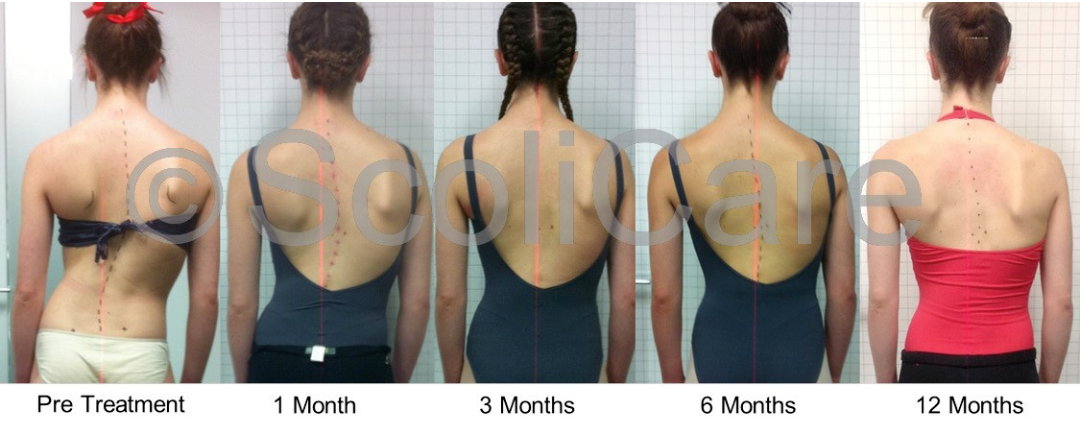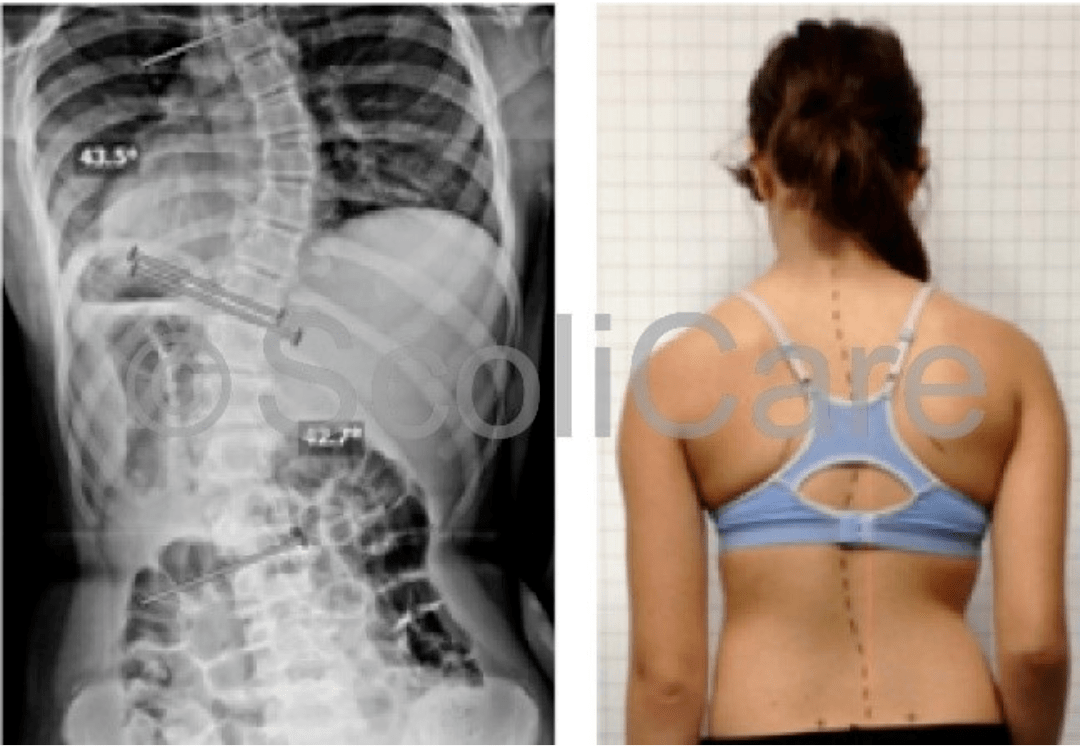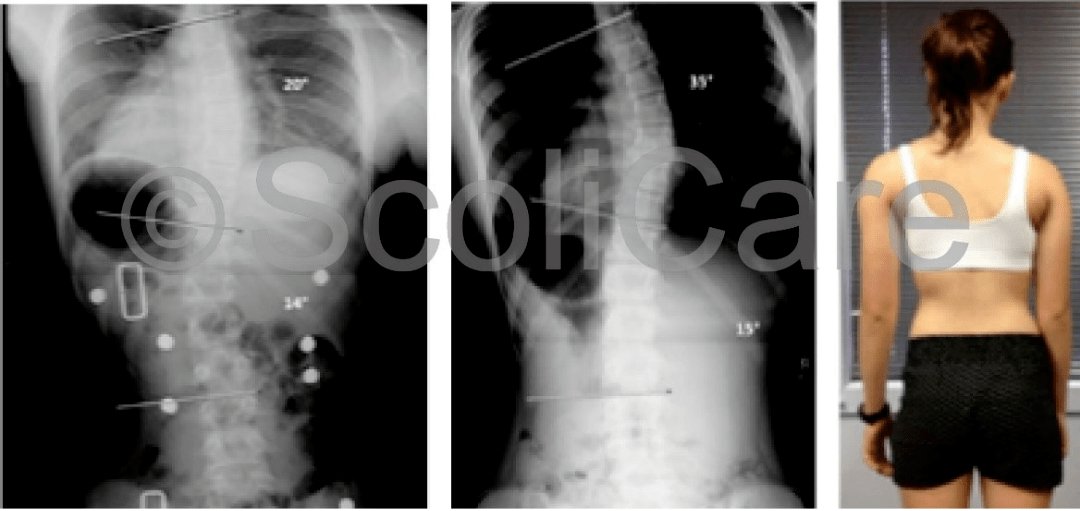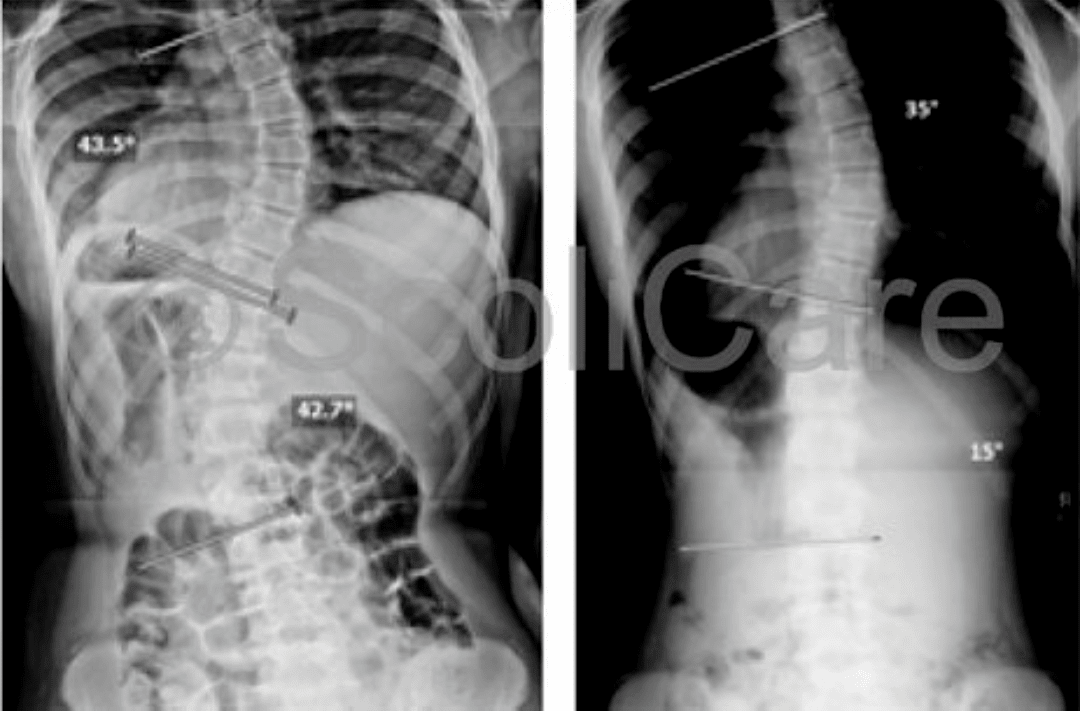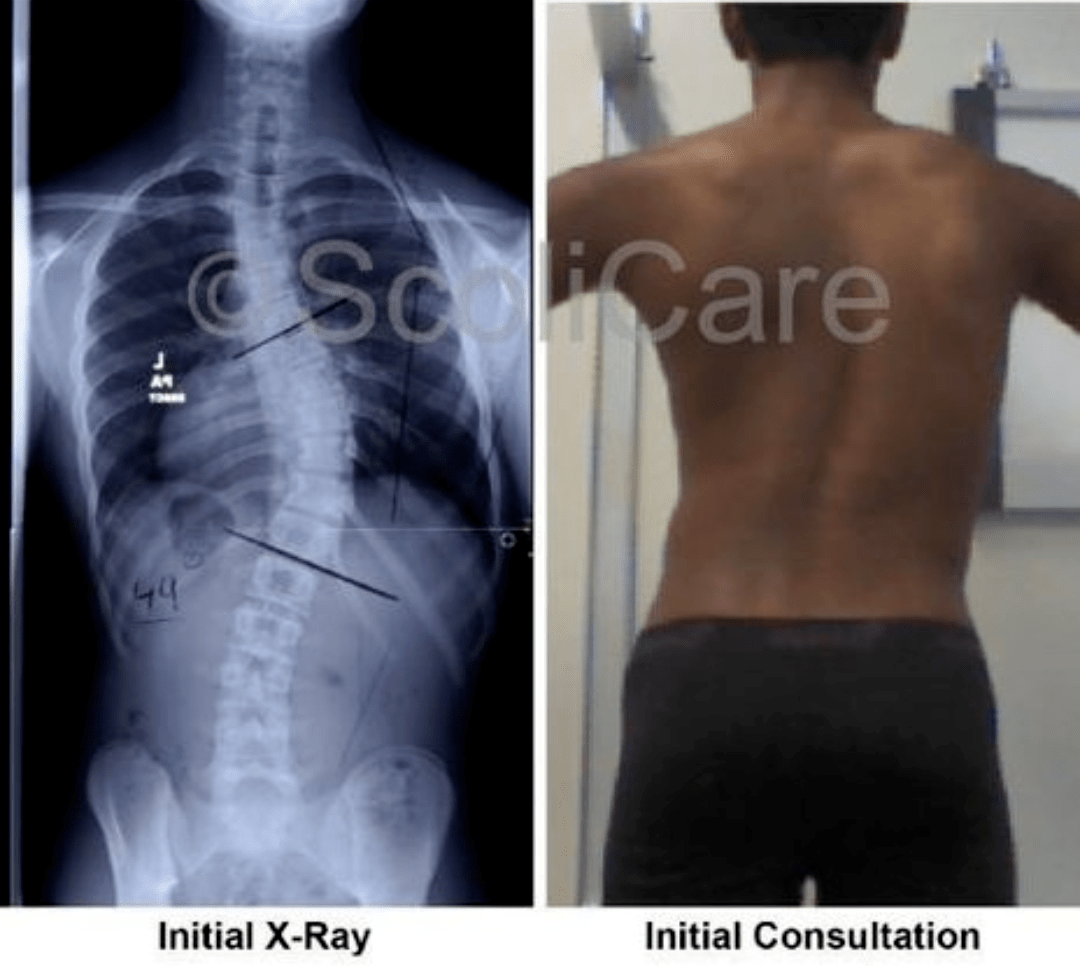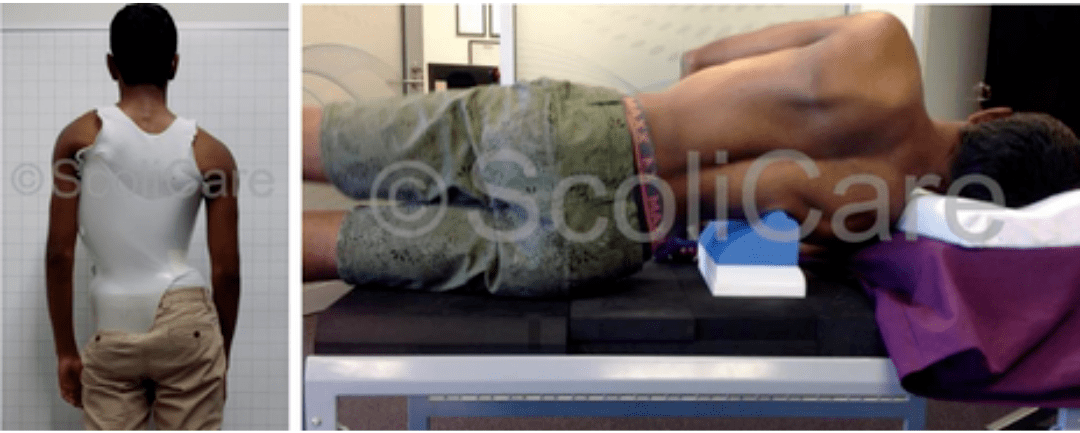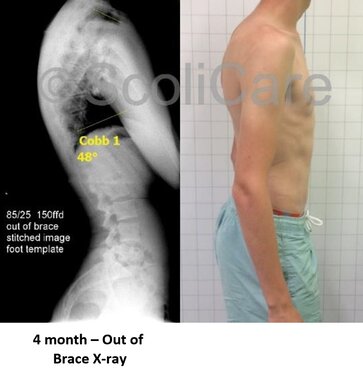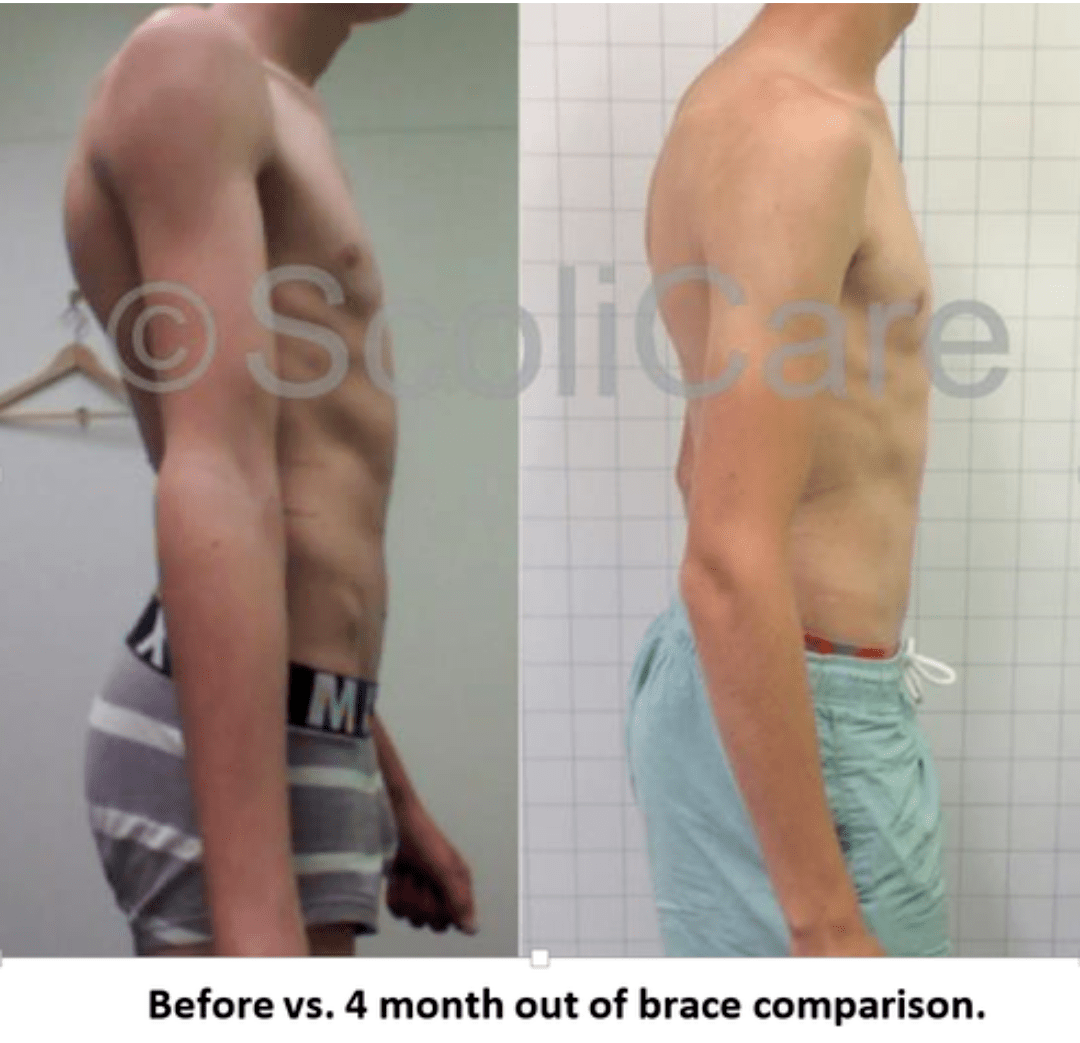Scoliosis and kyphosis
patient case studies
case study 1
Patient aged 17 with scoliosis curve measured 44 degrees reduced to 29 degrees
|
Background Patient presented to the Sydney Scoliosis Clinic aged 17 at the time of initial examination. Adolescent Idiopathic Scoliosis was diagnosed 18 months earlier and no treatment was undertaken during this time. At the initial consultation the scoliosis curve measured 44 degrees. This patient had seen a surgeon and was recommended to undergo surgery. She reported having bad back pain (7-8/10) most days. The pain was worse after dance classes. The patient was on track to become a professional ballet dancer however the pain and the effect of the scoliosis on the body posture and the effect that surgery would have on the spinal flexibility meant that this future career was at risk. |
Treatment
A combination of part-time rigid bracing using the mirror image ScoliBrace and the ScoliBalance scoliosis rehabilitation approach based on the SEAS principles was recommended. It was recommended to use the ScoliBrace for 6-8 hours per day and to do the ScoliBalance exercises twice per day for 20 minutes. This intensive regime was recommended for 3-6 months.
Results
As can be seen from the photos, a cosmetic improvement in the body was seen within the first 4 weeks. This improvement was maximised at 6 months. After the end of intensive treatment, the body posture settled to its new corrected position which is demonstrated at the 12 months photo.
At the 12 month mark an x-ray was taken with an independent radiology clinic with the patient standing in her relaxed normal posture. This shows a significant improvement in the scoliosis curve and the alignment of the spine. The curve was corrected by 15 degrees, reducing from 44 degrees to 29 degrees.
The patient’s pain was reduced to 2-3/10 and was only present on an occasional basis. As the body posture improved so did the performance at ballet. At the end of the intensive part of the treatment program the patient was selected to join a top ballet institution overseas. As a result of these improvements surgery was cancelled.
Discussion
This case demonstrates the potential for a combination of the mirror image ScoliBrace and ScoliBalance rehabilitation program to improve the cosmetic look of the body, the spinal alignment and degree of curve, and the pain associated with the scoliosis. Although relatively mature this patient was able to achieve 15 degrees of correction of her curve.
A combination of part-time rigid bracing using the mirror image ScoliBrace and the ScoliBalance scoliosis rehabilitation approach based on the SEAS principles was recommended. It was recommended to use the ScoliBrace for 6-8 hours per day and to do the ScoliBalance exercises twice per day for 20 minutes. This intensive regime was recommended for 3-6 months.
Results
As can be seen from the photos, a cosmetic improvement in the body was seen within the first 4 weeks. This improvement was maximised at 6 months. After the end of intensive treatment, the body posture settled to its new corrected position which is demonstrated at the 12 months photo.
At the 12 month mark an x-ray was taken with an independent radiology clinic with the patient standing in her relaxed normal posture. This shows a significant improvement in the scoliosis curve and the alignment of the spine. The curve was corrected by 15 degrees, reducing from 44 degrees to 29 degrees.
The patient’s pain was reduced to 2-3/10 and was only present on an occasional basis. As the body posture improved so did the performance at ballet. At the end of the intensive part of the treatment program the patient was selected to join a top ballet institution overseas. As a result of these improvements surgery was cancelled.
Discussion
This case demonstrates the potential for a combination of the mirror image ScoliBrace and ScoliBalance rehabilitation program to improve the cosmetic look of the body, the spinal alignment and degree of curve, and the pain associated with the scoliosis. Although relatively mature this patient was able to achieve 15 degrees of correction of her curve.
Although this may not be achievable in every case it shows that in cases where the patient is flexible and there is an aspect of the scoliosis that is not fixed it is possible to make correction even after growth has finished. Continuation of the ScoliBalance exercises may be required to maintain the correction.
|
Conclusion
In this case it was possible to reduce a large curve that was at a surgical level to a moderate curve no longer in need of surgery. Choosing the right treatment to achieve the goals of cosmetic improvement, curve reduction, and pain relief was successful in this case. NB: Results vary from case to case. Our commitment is to recommend the most appropriate treatment based on the patient’s type and severity of scoliosis. © ScoliCare 2014 This case study is provided courtesy of Scolicare (www.scolicare.com.au) |
Case Study 2
Patient aged 13 with scoliosis curve measured 44° in the thoracic spine and 43° in the lumbar spine reduced to 35° and 15° in 8 months.
Results
As can be seen from the photos, a cosmetic improvement in the body was seen within the first 3 months. This improvement was maintained at 12 and 18 months. At the 3 month mark an in-brace x-ray was taken showing very good correction of the curve. The thoracic curve reduced from 44 to 20 degrees and the lumbar curve reduced from 43 to 14 degrees (in the brace). At the 8 month mark an out-of-brace x-ray was taken at an independent radiology clinic, with the patient standing in her relaxed normal posture. This showed a significant improvement in the scoliosis curves. The lumbar curve was corrected by a staggering 28 degrees! The thoracic spine curve was corrected by 9°.The patient has continued with compliant treatment, and postural photographs at the 12 and 18 month mark show stability of the result. She is continuing with treatment.
Discussion This case demonstrates the powerful super-corrective effect of the ScoliBrace and how the addition of the ScoliRoll can work with the corrective approach of the ScoliBrace. This combination of treatment has been able to improve the cosmetic look of the body, the spinal alignment and the degree of curve. Although still immature and undergoing treatment, this case represents a positive initial result that will likely result in this patient avoiding spinal fusion surgery in the future.
|
Case Study 3
Male patient aged 14 years with a right thoracic curve measured at 49 degrees
|
Background
This patient was diagnosed with Scoliosis by his Physiotherapist at the age of 13 years old with a curve of 39 degrees. They first consulted a surgeon about the case who suggested surgery or bracing. A year later they presented to the Sydney Scoliosis Clinic for bracing and the curve had progressed a further 10 degrees. The patient was not experiencing any pain from the scoliosis, but did notice the asymmetrical shape of his torso. This patient is a National medallist in Athletics and also previously played representative Australian Rules Football. Due to his regular training, this patient had a good general strength and flexibility which was favourable when commencing brace and exercise treatment for scoliosis. Treatment This patient’s treatment involves wearing a ScoliBrace 23 hrs per day, ongoing SEAS rehab sessions and ScoliRoll tractioning. His brace wear started at 2 hrs per day, which was built up gradually over the following weeks to 23 hours each day. The patient does not compete in the brace but is very diligent in putting it back on straight after an event. |
The SEAS exercises require him to position his body in an active self-correction, which is the mirror image of his scoliosis, and to also work on strengthening his core and lower back muscles with exercises specifically prescribed for his case. He regularly sees our scoliosis specialist exercise physiologist to assess his progress and increase the difficulty of the exercises to ensure he keeps improving.
The patient does quite advanced SEAS exercises and we have now started incorporating his active self-correction to warm-up movements he does at training to help keep his spine in good alignment when he is out of the brace. The home exercises and ScoliRoll are done every day and take approximately 40mins to complete.
The patient does quite advanced SEAS exercises and we have now started incorporating his active self-correction to warm-up movements he does at training to help keep his spine in good alignment when he is out of the brace. The home exercises and ScoliRoll are done every day and take approximately 40mins to complete.
|
Results
We have seen a great improvement in this patient’s posture in the first 12 months of treatment and he still continues to improve. The intial curve of 49 degrees, has now decreased to 35 degrees, which is a considerable achievement for this type of curve. Due to his age and currently being Risser 4, it is essential for the brace treatment to continue while he is still growing. If left untreated, the scoliosis can progress further with growth. |
At the beginning of the treatment, the patient was not competing at his best, but after a period of adaptation and the inclusion of specific exercises, he is now excelling and is back to the optimal form he was in prior to starting his scoliosis treatment.
The patient and his family are very committed to his treatment and to helping him succeed. The patient is a very motivated young man and his hard work is definitely paying off with the results he has achieved so far.
The patient and his family are very committed to his treatment and to helping him succeed. The patient is a very motivated young man and his hard work is definitely paying off with the results he has achieved so far.
Conclusion
In this case it was possible to reduce a large curve that was at a surgical level to a moderate curve no longer at risk of needing surgery. Choosing the right treatment to achieve the goals of cosmetic improvement, curve reduction, and pain relief was successful in this case.
The patient was also able to continue competing at an elite level without compromising his ability
NB: Results vary from case to case. Our commitment is to recommend the most appropriate treatment based on the patient’s type and severity of scoliosis.
© ScoliCare 2015
This case study is provided courtesy of ScoliCare (www.scolicare.com.au)
In this case it was possible to reduce a large curve that was at a surgical level to a moderate curve no longer at risk of needing surgery. Choosing the right treatment to achieve the goals of cosmetic improvement, curve reduction, and pain relief was successful in this case.
The patient was also able to continue competing at an elite level without compromising his ability
NB: Results vary from case to case. Our commitment is to recommend the most appropriate treatment based on the patient’s type and severity of scoliosis.
© ScoliCare 2015
This case study is provided courtesy of ScoliCare (www.scolicare.com.au)
Case Study 4
Patient aged 7 years with scoliosis thoracic curve measured at 32 degrees and lumbar curve measured at 27 degrees.
|
Background
Patient presented to the Sydney Scoliosis Clinic, aged 7 years at the time on initial examination. This patient had been recommended and fitted with a traditional 3 point pressure hospital made TLSO. This brace had achieved minimal in-brace correction – the thoracic curve had been reduced from 32 to 21 degrees. The lumbar curve remained the same in brace. |
Treatment
The patient was switched to the super corrective ScoliBrace. New in-brace x-rays show a dramatically better in-brace correction in the ScoliBrace compared to the hospital TLSO.
Results
Thoracic curve reduced to 13 degrees which was a correction of 19 degrees and 8 degrees better than the hospital brace. The lumbar curve reduced to 3 degrees which was a correction of 24 degrees. The hospital brace made NO improvement in the lumbar curve.
The patient was switched to the super corrective ScoliBrace. New in-brace x-rays show a dramatically better in-brace correction in the ScoliBrace compared to the hospital TLSO.
Results
Thoracic curve reduced to 13 degrees which was a correction of 19 degrees and 8 degrees better than the hospital brace. The lumbar curve reduced to 3 degrees which was a correction of 24 degrees. The hospital brace made NO improvement in the lumbar curve.
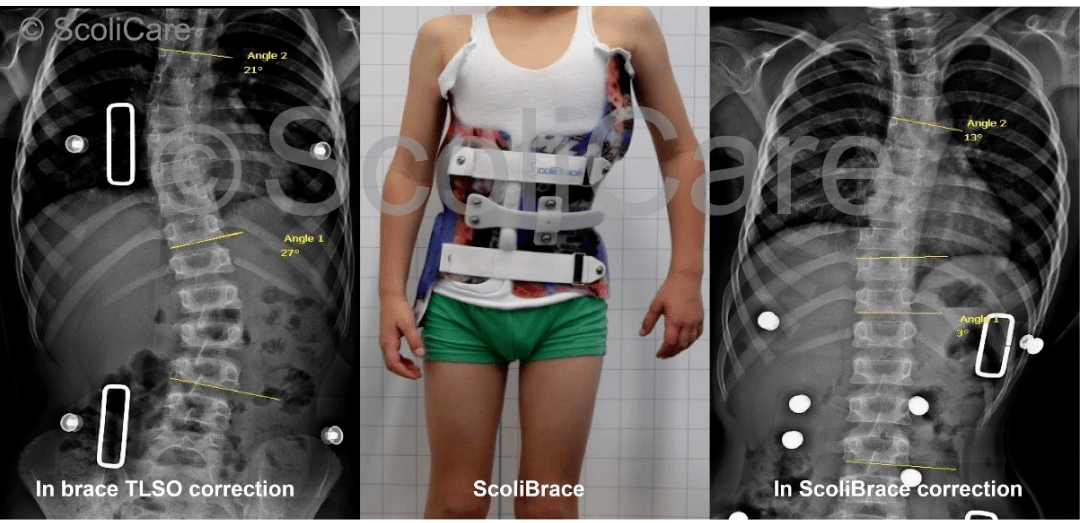 Patient's condition improves after changing treatment
Patient's condition improves after changing treatment
Discussion
ScoliBrace is not a traditional 3 point pressure brace. Instead the brace uses a concept of spinal repositioning by over correcting the body posture and using specific 3D moulding to main the correction in the brace. As highlighted in Stokes review on bracing published in Bone Joint Journal. 2013 titled “The current status of bracing for patients with adolescent idiopathic scoliosis”. Stokes states that; “In conclusion…The Hueter–Volkmann principle holds true for bracing in AIS. If a brace does not correct a curve on application, then either the brace has not been designed, manufactured or fitted correctly, or the curve cannot be braced.”
This case demonstrates a clear difference in corrective effect on the same patient by two different braces. One of the braces had poor correction and most likely would have not stopped progression of the curve. The other had good correction and has a much high chance of stopping progression or improving the curve.
Conclusion
Not all braces are the same. In this case the ScoliBrace clearly showed a superior in-brace correction to the hospital manufactured brace for the same patient. Although this case has not reached its end point and treatment is ongoing, the initial requirements needed for a ScoliBrace to demonstrate its potential usefulness in the treatment of idiopathic scoliosis is demonstrated in this case.
NB: Results vary from case to case. Our commitment is to recommend the most appropriate treatment based on the patient’s type and severity of scoliosis.
© ScoliCare 2014
This case study is provided courtesy of Scolicare (www.scolicare.com.au)
ScoliBrace is not a traditional 3 point pressure brace. Instead the brace uses a concept of spinal repositioning by over correcting the body posture and using specific 3D moulding to main the correction in the brace. As highlighted in Stokes review on bracing published in Bone Joint Journal. 2013 titled “The current status of bracing for patients with adolescent idiopathic scoliosis”. Stokes states that; “In conclusion…The Hueter–Volkmann principle holds true for bracing in AIS. If a brace does not correct a curve on application, then either the brace has not been designed, manufactured or fitted correctly, or the curve cannot be braced.”
This case demonstrates a clear difference in corrective effect on the same patient by two different braces. One of the braces had poor correction and most likely would have not stopped progression of the curve. The other had good correction and has a much high chance of stopping progression or improving the curve.
Conclusion
Not all braces are the same. In this case the ScoliBrace clearly showed a superior in-brace correction to the hospital manufactured brace for the same patient. Although this case has not reached its end point and treatment is ongoing, the initial requirements needed for a ScoliBrace to demonstrate its potential usefulness in the treatment of idiopathic scoliosis is demonstrated in this case.
NB: Results vary from case to case. Our commitment is to recommend the most appropriate treatment based on the patient’s type and severity of scoliosis.
© ScoliCare 2014
This case study is provided courtesy of Scolicare (www.scolicare.com.au)
Case Study 5
Patient aged 16 years with Kyphosis measured at 61 degrees
|
Background Patient presented to the Melbourne Scoliosis Clinic aged 16 years at the time of initial examination complaining of a sore back and poor posture. He was diagnosed with a Scheuermann’s kyphosis measuring 61 degrees. Treatment A specialised brace for kyphosis treatment called a KyphoBrace was recommend to help reduce and stabilize the kyphosis. It was recommended that the KyphoBrace be worn for 20 hours per day for a 24 month period. |
Results
In the brace you can see that the patient posture is greatly improved. The brace is also very low profile and with clothes over the top is nearly impossible to see.
At the 3 month mark, an in-brace x-ray was taken. The in-brace kyphosis had reduced to 47 degrees.
After 4 months of treatment, an out of brace x-ray was taken. The Kyphosis had reduced from 61 to 48 degrees.
In the brace you can see that the patient posture is greatly improved. The brace is also very low profile and with clothes over the top is nearly impossible to see.
At the 3 month mark, an in-brace x-ray was taken. The in-brace kyphosis had reduced to 47 degrees.
After 4 months of treatment, an out of brace x-ray was taken. The Kyphosis had reduced from 61 to 48 degrees.
Discussion
Scheuermann’s kyphosis is a progressive spinal deformity that can worsen with growth and if it gets too severe requires surgery. Bracing is recommended when a Kyphosis progresses beyond 60 degrees as there is a tendency for the curve to continue to worsen even after growth has finished. Surgery is often recommended if the curve is greater than 70 degrees.
Old fashion braces, such as the Milwaukee brace, used to be the only way to non-surgically treat kyphosis. The development of the KyphoBrace however, means there is now an effective bracing treatment for kyphosis in teens and young adults that can not only hold but also reduce the kyphosis and is low profile and hardly visible under clothing.
Scheuermann’s kyphosis is a progressive spinal deformity that can worsen with growth and if it gets too severe requires surgery. Bracing is recommended when a Kyphosis progresses beyond 60 degrees as there is a tendency for the curve to continue to worsen even after growth has finished. Surgery is often recommended if the curve is greater than 70 degrees.
Old fashion braces, such as the Milwaukee brace, used to be the only way to non-surgically treat kyphosis. The development of the KyphoBrace however, means there is now an effective bracing treatment for kyphosis in teens and young adults that can not only hold but also reduce the kyphosis and is low profile and hardly visible under clothing.
|
Conclusion This case demonstrates that that KyphoBrace is an effective treatment for Scheuermann’s kyphosis. Both improvements in the patient’s postural appearance, and the degree of the curve on x-ray are demonstrated. NB: Results vary from case to case. Our commitment is to recommend the most appropriate treatment based on the patient’s type and severity of scoliosis. © ScoliCare and Melbourne Scoliosis Clinic 2015 This case study is provided courtesy of Scolicare (www.scolicare.com.au) |


